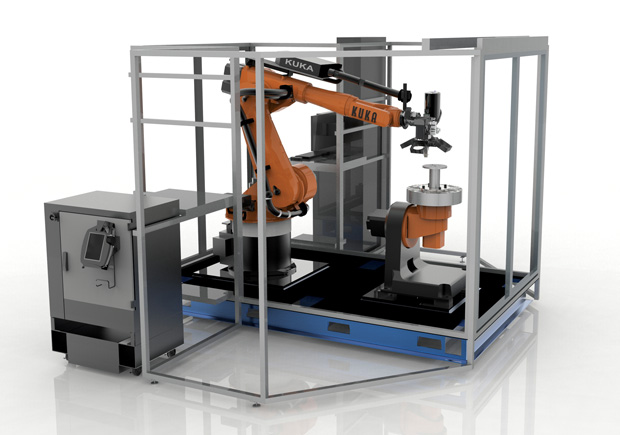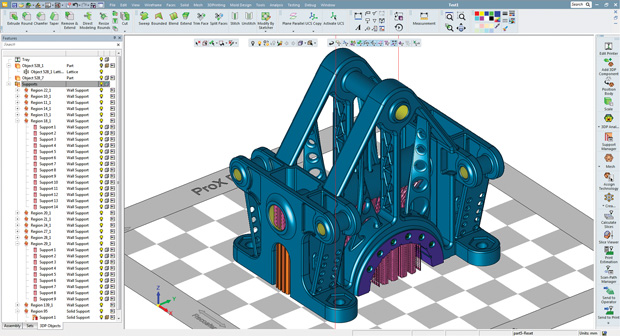Manufacturing Goes Digital

Siemens’ NX Hybrid Additive Manufacturing provides laser and NC programming with simulation for the DMG MORI Lasertec machine tool series where metal deposition is incorporated with machining on a single machine. Image courtesy of Siemens PLM Software.
Latest News
November 1, 2016
 The Robotic Composite 3D Demonstrator from Stratasys uses a robotic arm with an extruder for greater motion control. Image courtesy of Stratasys.
The Robotic Composite 3D Demonstrator from Stratasys uses a robotic arm with an extruder for greater motion control. Image courtesy of Stratasys.Production-level additive manufacturing (AM) is entering the industry spotlight. In September, GE announced its intent to acquire industrial AM companies Arcam AB and SLM Solutions Group AG for $1.4 billion. (Editor’s note: It has since dropped its bid for SLM Solutions and acquired Concept Laser.) Siemens also stepped up its stake in the technology by becoming a major stakeholder in Materials Solutions Ltd., a provider of AM processing and production. More companies are beginning to invest in AM because they see them as integral to their digital manufacturing plans.
“Additive manufacturing is a key part of GE’s evolution into a digital industrial company,” said Jeff Immelt, chairman and CEO of GE, via a press release. “We are creating a more productive world with our innovative world-class machines, materials and software. We are poised to not only benefit from this movement as a customer, but spearhead it as a leading supplier.”
Digital manufacturing integrates the use of design, simulation and data analytics software to simultaneously produce products and develop best practices for manufacturing. Its goals include increased collaboration between design and production as well as collecting usable information for both departments.
“As you’re producing parts [with digital manufacturing], you’re learning more and more about how that part is made … so by the time that individual product rolls off the production line, you have a tremendous amount of information of how that part was designed and how that part was produced,” says Dean Bartles, chief manufacturing officer and executive director at the Digital Manufacturing & Design Innovation Institute (DMDII).
GE says it expects to grow its new additive business to $1 billion by 2020 and also expects $3-5 billion of product cost-out across the company over the next 10 years. Other examples of advancing the industrial integration of AM include Siemens PLM Software partnering with Stratasys and DMG MORI; 3D Systems linking up with PTC; and the DMDII expanding its grants and research projects.
According to DMDII, 81% of U.S. manufacturers recognized digital manufacturing as an element of competitiveness, but only 14% believed that they were adequately equipped with related technology and expertise. The factory of the future will include three main things: intelligent automation, robotics and additive manufacturing, according to Aaron Frankel, marketing director for Manufacturing Engineering Software at Siemens PLM Software. “A digital environment unites the digital and the physical—and it does it in such a way to create a digital twin,” he notes. “We’re at the very beginning of seeing additive being used in industrial processes.”
Bringing Systems Up to Speed
One way AM vendors are advancing their products is by integrating robotics to automate the process. Over the past several months, 3D Systems and Stratasys have announced new technologies to address manufacturers’ needs: Figure 4 from 3D Systems and an Infinite-Build 3D Demonstrator and Robotic Composite 3D Demonstrator from Stratasys.
All three of these systems leverage robot technology for more flexible, faster and larger builds. 3D System’s Figure 4 technology builds on an original patent from co-founder Chuck Hull. The vat-based stereolithography system uses multi-mode polymerization and robotics to complete production, material recovery and curing. To produce a part, the build plate is pulled up from the material and cured through a chemical process.
Stratasys’ systems rely on its FDM (Fused Deposition Modeling) process. The Infinite-Build 3D Demonstrator creates parts on a vertical plane, for increased scale and greater part size. A robotic arm is used to automated material replacement during the build. The Robotic Composite 3D Demonstrator brings greater design capabilities by attaching an extruder to an 8-axis robotic arm motion system driven by Siemens PLM Software’s NX, eliminating the need for support structures.
In addition to the announcements from 3D Systems and Stratasys, this year’s International Manufacturing Technology Show (IMTS) brought many other systems into the spotlight. ExOne, Renishaw and EOS North America were among the companies sporting new production-level and metal-based systems.
Last year, ExOne announced its Exerial additive manufacturing system, which is designed for simultaneous, large-scale printing. It is equipped with two job boxes for greater print capacity and sports a total build platform of 3,168 liters using binder jetting technology.
Renishaw showcased its RenAM 500M production system, which uses metal alloys for end-use level products. Functions such as powder sieving and recirculation are all automated, and it is designed to reduce handling of materials.
EOS introduced its FORMIGA P 110 system that directly uses CAD data to produce polymer parts in a build space of 7.8x9.8x13 in. The company says it has a high degree of automation for material handling and integration, allowing for “minimal downtimes and increased productivity.”
One key common feature in these systems is an increased degree of automation. For example, 3D System’s Figure 4 would be slowed down by manual intervention. “Because of the velocity at which it can produce recurring geometry, and with the scale we can get to using multiple modules, automation is just a natural part of it,” says Scott Turner, senior researcher at 3D Systems. “Having labor trying to handle hundreds of parts an hour can be difficult.”
Software and Time Savings
AM hardware is only part of the digital manufacturing solution. Software integration and design-to-production collaboration is only possible via a digital thread that connects the product lifecycle. With the two-way connection between manufacturing and engineering design, any changes throughout the design process or in the original CAD files can be implemented in real-time.
When it comes to creating support structures, converting files and selecting post-processing settings for AM, “the software tools will enable [engineers] to optimize the printing process,” says Sridharan Hariharan, director of Applications Engineering & Training, Software Business Unit at 3D Systems.
 3DXpert provides an all-in-one toolset for metal 3D printing and production. Image courtesy of 3D Systems.
3DXpert provides an all-in-one toolset for metal 3D printing and production. Image courtesy of 3D Systems.3D Systems introduced 3DXpert last month to provide an end-to-end process for design, pre-printing preparations (support generation, topology optimization) and post-printing processes (subtractive manufacturing or finishing, for example). It uses an original CAD model as the basis of the AM-made part and provides complete control of the printing process, including zoning
“Especially for [engineers] using additive manufacturing and having post-printing operations, [3DXpert] will enable them to be more efficient, more productive,” Hariharan says. This ability to access various manufacturing methods within one software suite will help integration of metal additive manufacturing into traditional manufacturing environments, he adds.
Additionally, having a digital copy of the part for production allows for easier reproducibility, and the ability to capture the most optimized design. This almost makes it a self-improving process, Frankel says. With a software-based backbone, manufacturing environments can predict performance and accumulate knowledge to capture the best way to do things. It’s also easier to transmit new workflow changes because the environment is completely connected to a software infrastructure.
 Siemens’ NX Hybrid Additive Manufacturing provides laser and NC programming with simulation for the DMG MORI Lasertec machine tool series where metal deposition is incorporated with machining on a single machine. Image courtesy of Siemens PLM Software.
Siemens’ NX Hybrid Additive Manufacturing provides laser and NC programming with simulation for the DMG MORI Lasertec machine tool series where metal deposition is incorporated with machining on a single machine. Image courtesy of Siemens PLM Software.This combination of hardware, software and industry partnerships is just helping set the stage for next-gen manufacturing. “Technology developers and adopters need to continue to stay open and work together to figure out what works best,” Frankel says.
More Info
Subscribe to our FREE magazine, FREE email newsletters or both!
Latest News
About the Author
Jess Lulka is a former associate editor for Digital Engineering. Contact her via de-editors@digitaleng.news.
Follow DE





